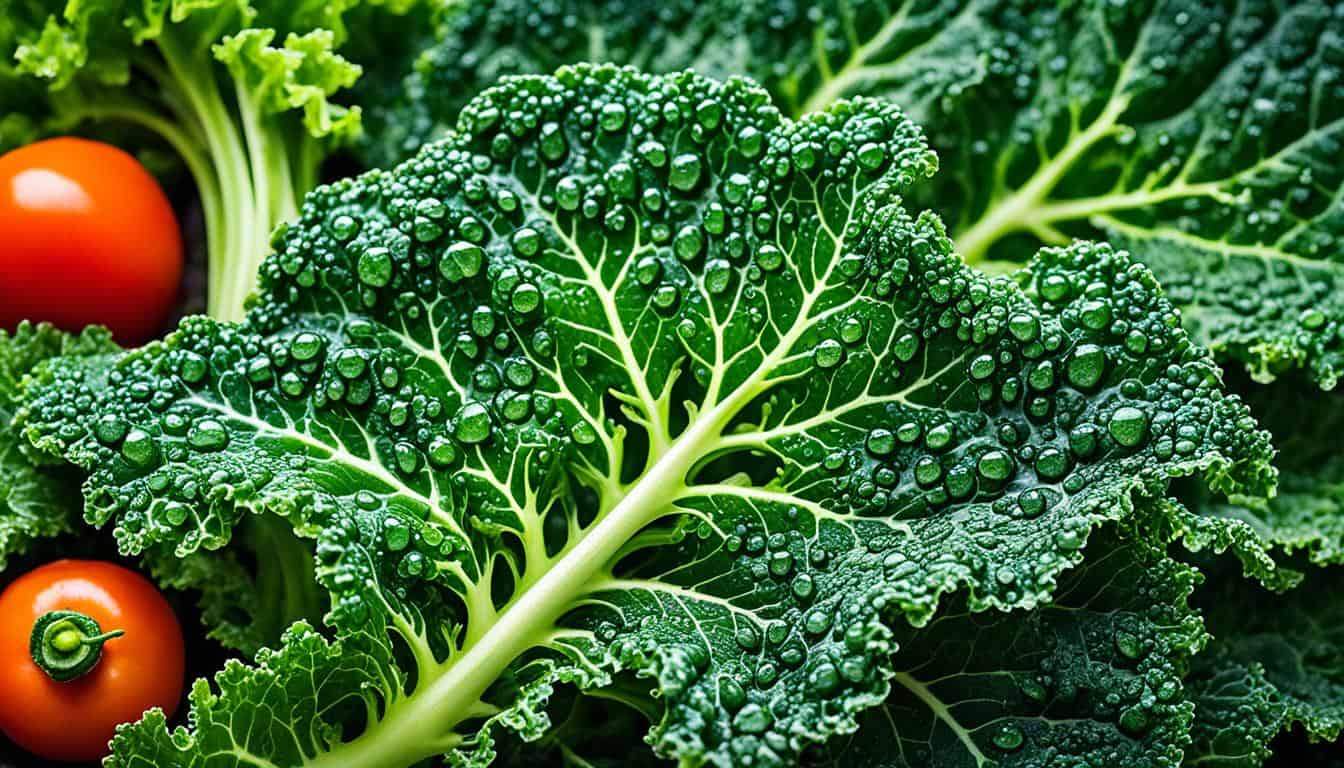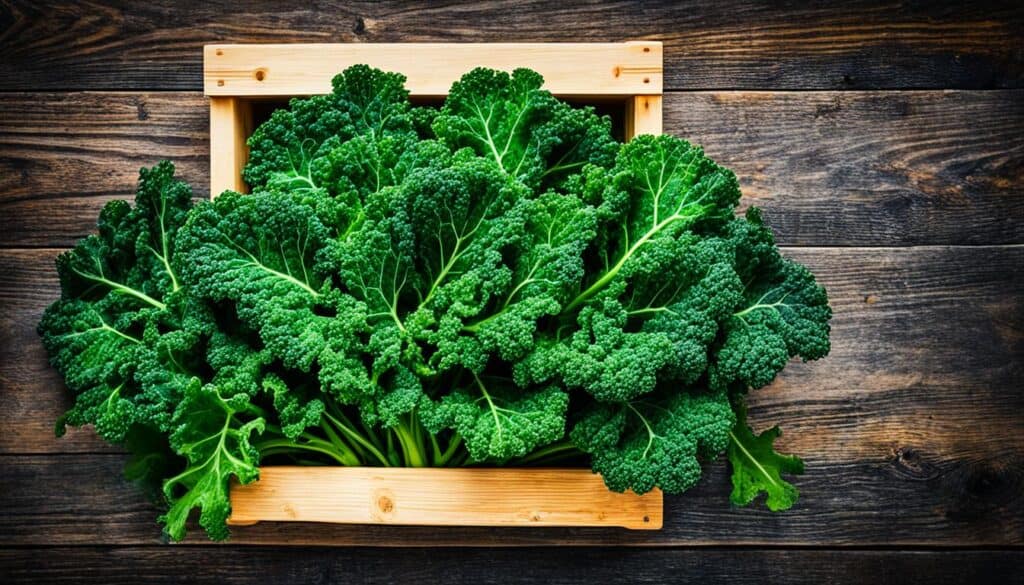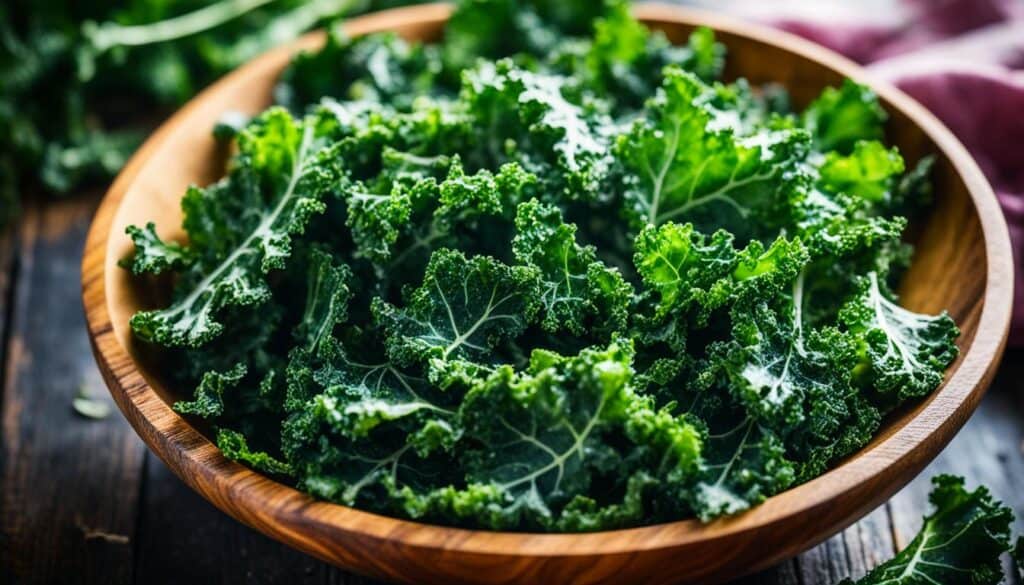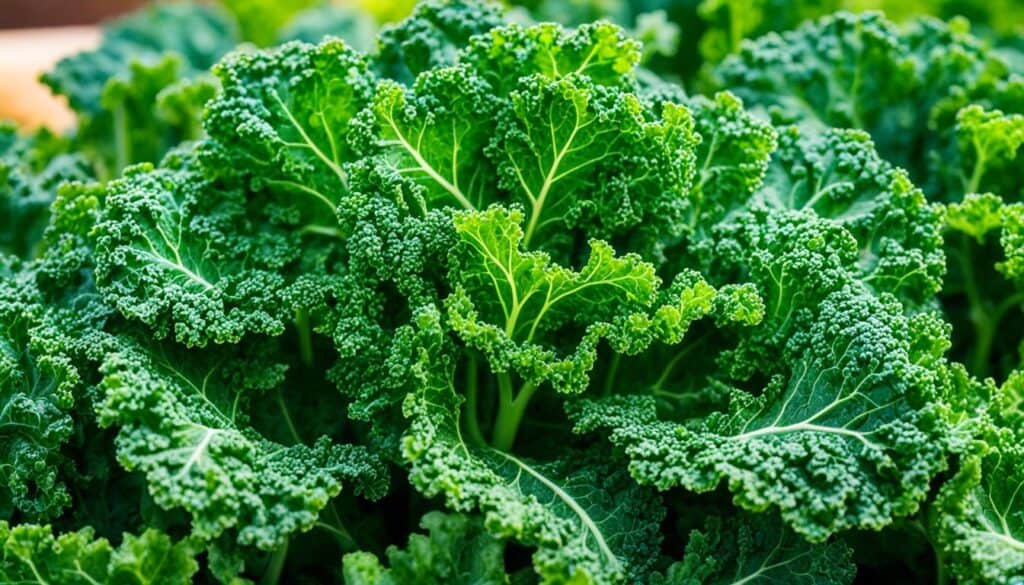Did you know that curly kale, a leafy green vegetable, is considered a superfood that offers a plethora of health benefits? Not only is it packed with essential vitamins and minerals, but it is also readily available and can be incorporated into a variety of delicious dishes. Whether you prefer it raw in salads or crispy in chips, curly kale is a versatile and nutrient-rich option for promoting vibrant health.
Key Takeaways:
- Curly kale is a nutrient-rich superfood that promotes vibrant health.
- It is packed with essential vitamins and minerals.
- Curly kale is versatile and can be used in a variety of dishes.
- It is important to avoid overcooking curly kale to preserve its vitamin C content.
- Curly kale is a local produce option that is readily available.
The History and Types of Kale
Kale, a leafy green vegetable, has a rich and fascinating history that dates back centuries. In fact, it has been enjoyed for its unique flavor and nutritional benefits for generations. Did you know that even Thomas Jefferson, one of the founding fathers of the United States, grew kale in his garden and experimented with different varieties in the early 1800s? It’s clear that kale has long been cherished for its culinary versatility and health-promoting properties.
Curly kale, also known as Scots kale, is one of the most recognizable and commonly consumed types of kale. With its rich green color and distinctive curly leaves, it adds texture and flavor to a variety of dishes. Known for its slightly bitter and peppery taste, curly kale brings a unique punch to salads, soups, and stir-fries.
While curly kale is the star of the show, there are other interesting varieties of kale to explore. Here are a few examples:
- Dinosaur Kale: Also known as Lacinato or Tuscan kale, this variety features dark blue-green leaves with a ridged texture. Its earthy and slightly sweeter taste makes it a favorite among kale enthusiasts.
- Redbor Kale: With its stunning purple-red leaves, redbor kale not only adds vibrant color to your plate but also delivers a mild and slightly sweet flavor. It’s a great option for salads and garnishes.
- Russian Kale: A hardy and frost-resistant variety, Russian kale has flat, fringed leaves that are green with a hint of purple. It offers a more delicate flavor compared to curly kale, making it a versatile choice for various culinary creations.
You can find kale at your local farmers markets or grocery stores, usually sold in fresh bunches or conveniently prewashed and trimmed in bags. No matter the variety you choose, kale is a nutritious and flavorful addition to your meals.
Kale’s Nutritional Powerhouse
Kale is considered a nutrition superstar due to its impressive nutrient profile. It is rich in vitamins A, B6, C, and K, as well as folate, fiber, carotenoids, and manganese. One cup of raw kale contains just 20 calories, making it a low-calorie option. The cruciferous vegetable family, which includes kale, offers various health benefits, such as supporting the immune system and potentially reducing the risk of certain types of cancer.
“Kale is not only delicious but also one of the most nutrient-dense foods on the planet. It’s a true nutritional powerhouse that can significantly contribute to a balanced and healthy diet.”
The Benefits of Kale’s Nutrients:
- Vitamin A: Supports eye health and boosts the immune system.
- Vitamin B6: Essential for brain development and function.
- Vitamin C: Strengthens the immune system and promotes collagen production.
- Vitamin K: Important for blood clotting and bone health.
- Folate: Necessary for DNA synthesis and cell growth.
- Fiber: Aids digestion, promotes satiety, and supports heart health.
- Carotenoids: Antioxidants that protect against cellular damage.
- Manganese: Supports bone health and metabolism.
Caution:
However, it is important to note that individuals with oxalate-containing kidney stones or those on blood thinners should consult their healthcare professionals before consuming kale.
| Nutrient | Amount per 1 cup (chopped) |
|---|---|
| Vitamin A | 206% of the Daily Value (DV) |
| Vitamin C | 134% of DV |
| Vitamin K | 684% of DV |
| Vitamin B6 | 9% of DV |
| Folate | 5% of DV |
| Fiber | 2.6 grams |
| Manganese | 26% of DV |
Cooking with Curly Kale
Curly kale is a versatile leafy green that can be cooked in various ways, allowing you to explore different flavors and textures. Whether you prefer it steamed, stir-fried, roasted, or even raw, curly kale offers a range of culinary possibilities. Here are some delicious ways to incorporate curly kale into your meals:
1. Steamed Kale
Steaming kale helps retain its vibrant color and crisp texture. Simply remove the tough stems and roughly chop the leaves. Place the kale in a steamer basket over a pot of boiling water and steam for about 5 minutes until tender. Serve as a side dish or add it to grain bowls.
2. Stir-Fried Kale
Stir-frying kale is a quick and flavorful way to enjoy this nutritious green. Heat some oil in a pan, add minced garlic, and sauté until fragrant. Then, add the kale leaves and stir-fry for a few minutes until wilted. Season with soy sauce or lemon juice for a tangy twist.
3. Roasted Kale
Roasting kale creates crispy, addictive kale chips that make a healthy and satisfying snack. Remove the stems and tear the leaves into bite-sized pieces. Toss them with olive oil, salt, and your favorite seasonings. Spread the kale on a baking sheet and roast in a preheated oven at 350°F (175°C) for about 10-15 minutes until crispy.
4. Raw Kale
Raw kale adds a fresh and crunchy element to salads. Massage the kale leaves with a bit of olive oil to help break down their tough texture. Then, toss it with your favorite dressings, toppings, and other vegetables for a nutritious and vibrant salad.
5. Kale Pesto
Put a twist on traditional pesto by replacing basil with kale. Blend kale leaves, garlic, toasted pine nuts, Parmesan cheese, and olive oil until smooth. Use this flavorful pesto as a spread on sandwiches, a topping for pizzas, or a sauce for pasta dishes.
6. Cream of Wild Rice Soup with Kale
One popular recipe that highlights the flavors of curly kale is the creamy wild rice soup with kale. This hearty and nutritious soup combines cooked wild rice, sautéed onions, carrots, celery, vegetable broth, and curly kale. Simmer all the ingredients together until the flavors meld together, creating a comforting bowl of goodness.
With these cooking methods and recipes, you can explore the versatility of curly kale and create delicious dishes that showcase its unique flavors and nutritional benefits.
Choosing and Storing Curly Kale
When it comes to incorporating nutritious curly kale into your diet, it’s essential to select the best quality and store it properly to maintain its freshness and flavor. Here are some tips on choosing and storing curly kale:
Choosing Curly Kale:
When selecting curly kale, look for leaves that are dark green and vibrant. Avoid any bunches with yellowing or browning leaves, as these indicate age or spoilage. Additionally, ensure that the stalks are firm and dry, indicating freshness. Whether you’re shopping at local farmers’ markets, grocery stores, or even picking from your own garden, these visual cues can help you find the finest quality curly kale.
Storing Curly Kale:
Once you’ve brought your curly kale home, it’s important to store it properly to maximize its shelf life:
- Remove any ties or bands that might restrict air circulation.
- Rinse the curly kale leaves under cold water to remove any dirt or debris. Ensure that you dry them thoroughly, as excess moisture can promote wilting and decay.
- Loosely wrap the leaves in a paper towel or place them in a breathable plastic bag. Avoid sealing the bag too tightly, as this can trap moisture and cause the leaves to rot.
- Store the curly kale in the refrigerator’s crisper drawer, where the temperature and humidity are optimal for maintaining its freshness.
- Consume the curly kale within five days for the best flavor and texture. Over time, prolonged storage can cause the leaves to toughen.
Tip: For a convenient option, consider pre-washed and pre-cut curly kale sold in bags. These can save you time and effort in preparation while still providing the same nutritional benefits.
By following these guidelines, you can ensure that your curly kale remains fresh and ready to use whenever you’re ready to prepare a delicious and nutritious meal.
| Key Points |
|---|
| Choose curly kale with dark green leaves and firm, dry stalks. |
| Store curly kale loosely in the refrigerator’s crisper drawer. |
| Consume within five days to maintain optimal freshness. |
The Culinary Benefits of Massaging Curly Kale
Before adding curly kale to salads, it is recommended to massage the leaves with a little olive oil. This process helps tenderize the kale, making it easier to chew and digest. Massaged curly kale can be mixed with other ingredients like peppery rocket, juicy apple slices, currants, and toasted pine nuts to create a vibrant and nutritious salad. A light vinaigrette with a touch of sweetness can enhance the flavors of the salad.
Curly kale is not only packed with essential vitamins and minerals, but it also offers a plethora of health benefits. By massaging the kale leaves, you not only improve the texture but also unlock its maximum potential for your well-being.
Why Massage Curly Kale?
Massaging curly kale helps to break down its tough cell walls, which makes it easier to chew and digest. Additionally, massaging releases some of the natural sugars in the kale, which helps to reduce its bitterness and enhances the overall flavor profile of the dish.
Not only does massaging curly kale enhance its taste and texture, but it also makes it more nutritious. By breaking down the cell walls, the nutrients in kale become more accessible to your body, allowing you to reap the health benefits more effectively.
How to Massage Curly Kale
Massaging curly kale is a simple process that only takes a few minutes. Here’s how to do it:
- Start by washing the curly kale leaves and patting them dry.
- Remove the tough stems and tear the leaves into bite-sized pieces.
- Drizzle a small amount of olive oil over the kale.
- Gently massage the kale leaves for about 2-3 minutes, using your hands to rub and squeeze the leaves. This process helps to soften the leaves and break down their fibers.
- Once the kale leaves have become tender, they are ready to be used in salads or other recipes.
By taking a few minutes to massage your curly kale, you can transform it into a delicious and nutritious addition to your meals. Give it a try and savor the benefits!
Curly Kale as a Snack
Curly kale is not only a versatile vegetable for cooking, but it can also be a fantastic snack option. Transforming curly kale into crispy kale chips or incorporating it into refreshing smoothies is a great way to enjoy its nutritional benefits.
Making Crispy Kale Chips
If you’re looking for a healthy alternative to traditional potato chips, curly kale chips are the ideal choice. They are easy to make and incredibly delicious. Follow these simple steps to make your own homemade kale chips:
- Preheat your oven to 350°F (175°C).
- Remove the leaves from the stems and tear them into bite-sized pieces.
- In a bowl, toss the kale leaves with a drizzle of olive oil and a sprinkle of salt.
- Spread the seasoned kale leaves in a single layer on a baking sheet.
- Bake in the oven for 10-15 minutes or until the leaves turn crispy and slightly golden.
- Remove from the oven and let them cool for a few minutes before enjoying these delightful kale chips.
Kale chips are packed with flavor and provide a satisfying crunch. They make a fantastic snack for any time of the day and are a great way to include more curly kale in your diet.
Incorporating Curly Kale into Smoothies
Smoothies are an excellent way to incorporate curly kale into your daily routine. They can be a refreshing and nutritious option for a quick snack or a post-workout boost. Here’s a simple recipe for a curly kale smoothie:
- 1 cup of fresh curly kale leaves
- 1 ripe banana
- 1 cup of almond milk
- 1 tablespoon of honey
- 1 teaspoon of chia seeds
Blend all the ingredients together until smooth and creamy. You can add ice cubes for a chilled smoothie or adjust the consistency by adding more almond milk. This curly kale smoothie is not only delicious but also provides a wonderful combination of vitamins, minerals, and antioxidants.
Enjoying the Versatility of Curly Kale
Whether you prefer the crispy satisfaction of kale chips or the refreshing goodness of a curly kale smoothie, incorporating curly kale into your snack repertoire is a nutritious choice. It’s a fantastic way to enjoy the health benefits of curly kale while satisfying your cravings.
| Snack Option | Description |
|---|---|
| Kale Chips | Crispy, flavorful, and a great alternative to potato chips. They can be seasoned with various herbs and spices. |
| Curly Kale Smoothies | Refreshing and packed with nutrients. Can be customized with a variety of fruits, vegetables, and superfood additions. |
Considering Curly Kale’s Stem and Bitterness
While curly kale is packed with nutrients, its stems can be tough and fibrous, which can detract from the overall enjoyment of the vegetable. It is important to remove and discard the stems before using kale in recipes to fully appreciate the tender and flavorful leaves.
By focusing on the leaves and removing the stems, you can enhance the texture and taste of your curly kale dishes. Removing the stems also helps reduce any bitter taste that may be associated with them.
Here’s a simple step-by-step guide on removing kale stems:
- Hold the curly kale stem firmly with one hand.
- With your other hand, grab the base of the leaf and gently pull it away from the stem.
- Continue this process until you have removed all the leaves from the stem.
- Discard the stems and rinse the leaves thoroughly before using them in your recipes.
By removing the stems, you can fully enjoy the nutritional value of curly kale without any unwanted toughness or bitterness. Whether you’re preparing a delicious salad, stir-fry, or smoothie, taking the time to remove the stems will ensure a more enjoyable culinary experience.
Curly Kale Stem Removal Guide
| Step | Instructions |
|---|---|
| 1 | Hold the curly kale stem firmly with one hand. |
| 2 | With your other hand, grab the base of the leaf and gently pull it away from the stem. |
| 3 | Continue this process until you have removed all the leaves from the stem. |
| 4 | Discard the stems and rinse the leaves thoroughly before using them in your recipes. |
Removing the stems not only improves the taste and texture of curly kale but also allows you to fully appreciate its nutritional value. So, don’t forget to give your curly kale a stem-free makeover before indulging in its deliciousness!
Conclusion
Curly kale, with its vibrant green leaves and impressive nutritional profile, is truly a superfood that offers a range of health benefits. Whether you prefer it in salads, soups, or smoothies, curly kale can be incorporated into a variety of delicious recipes. By removing the tough stems and massaging the leaves, you can enhance the texture and flavor of this versatile leafy green.
With its rich content of vitamins A, B6, C, and K, as well as fiber and other essential nutrients, including curly kale in your diet can contribute to a healthier lifestyle. Its potential health benefits, such as supporting the immune system and reducing the risk of certain types of cancer, make it a valuable addition to any balanced eating plan.
So why not try out some curly kale recipes and discover the culinary possibilities it offers? From hearty salads to comforting soups and refreshing smoothies, curly kale can add a nutritious twist to your meals. Don’t forget to explore creative ways to enjoy curly kale, such as making kale chips or using it as a replacement for tortillas in wraps and sandwiches.
Make the most of this nutrient-dense superfood and introduce curly kale into your daily menu. Its vibrant flavor, versatile nature, and exceptional health benefits make it a standout ingredient that can help you nourish your body and maintain a vibrant, healthy lifestyle.










Leave a Reply